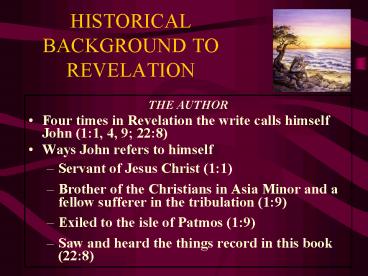HISTORICAL BACKGROUND TO REVELATION - PowerPoint PPT Presentation
1 / 20
Title:
HISTORICAL BACKGROUND TO REVELATION
Description:
... D. 153-217) apostle John returned from Isle of Patmos after the tyrants death ... notes that John left Patmos after the 'tyrant's death' but does not name him. ... – PowerPoint PPT presentation
Number of Views:75
Avg rating:3.0/5.0
Title: HISTORICAL BACKGROUND TO REVELATION
1
HISTORICAL BACKGROUND TO REVELATION
- THE AUTHOR
- Four times in Revelation the write calls himself
John (11, 4, 9 228) - Ways John refers to himself
- Servant of Jesus Christ (11)
- Brother of the Christians in Asia Minor and a
fellow sufferer in the tribulation (19) - Exiled to the isle of Patmos (19)
- Saw and heard the things record in this book
(228)
2
HISTORICAL BACKGROUND TO REVELATION
- THE AUTHOR
- Church history indicate it was John the apostle
- Justin Martyr (A. D. 110-165) John apostle of
Christ, prophesied by a revelation and refers to
the thousand years
3
HISTORICAL BACKGROUND TO REVELATION
- THE AUTHOR
- Church history indicate it was John the apostle
- Clement of Alexandria (A. D. 153-217) apostle
John returned from Isle of Patmos after the
tyrants death
4
HISTORICAL BACKGROUND TO REVELATION
- THE AUTHOR
- Church history indicate it was John the apostle
- Hippolytus (A. D. 170-236) Tell me, blessed
John, apostle and disciple of the Lord, what
didst thou see and hear concerning Babylon?
Then quotes chapter 17 18
5
HISTORICAL BACKGROUND TO REVELATION
- THE DATE
- Strong external evidence
- Domitian wanted to restore Roman religion and
encourage the worship of himself. - Early church fathers though Domitian was the
emperor during this time.
6
HISTORICAL BACKGROUND TO REVELATION
- THE DATE
- Strong external evidence
- Irenaeus (A. D. 180) Student of Polycarp who
was a student of John. was not very long ago,
almost in our own generation, at the close of the
reign of Domitian.
7
HISTORICAL BACKGROUND TO REVELATION
- THE DATE
- Strong external evidence
- Clement of Alexandria (A. D. 220) notes that
John left Patmos after the tyrants death but
does not name him. According to Eusebius (Father
of church history) tradition held this to be
Domitian.
8
HISTORICAL BACKGROUND TO REVELATION
- THE DATE
- Strong external evidence
- Victorinus (A. D. 303) martyred under
Diocletian stated, When John said these things
he was in the isle of Patmos, condemned to the
labor of the mines by Caesar Domitian. There,
therefore, he saw the Apocalypse. Later he
notes about the seven heads of the beast in Rev.
1710 that, One remains, under whom the
Apocalypse was written Domitian, to wit.
9
HISTORICAL BACKGROUND TO REVELATION
- THE DATE
- Strong external evidence
- Jerome (A. D. 340-420) Domitian raised up a
second persecution and John was banished to the
isle of Patmos and wrote the Apocalypse.
10
HISTORICAL BACKGROUND TO REVELATION
- THE DATE
- Internal evidence
- Spiritual conditions of the seven churches are
more in harmony with a late date. - Different from there situation in the last
mention of them in the letters and Acts.
11
HISTORICAL BACKGROUND TO REVELATION
- THE DATE
- Internal evidence
- Ephesus was planted about A. D. 61 if one takes
an early date a lot changed in just seven years. - Laodicea is reported to have great wealth (Rev.
317) but it was almost totally destroyed in A.
D. 60 by an earthquake.
12
HISTORICAL BACKGROUND TO REVELATION
- THE DATE
- Internal evidence
- It is unlikely to have been able to rebuild and
become rich in a short time for the period of
Nero. - Conclusion External and internal evidence fit
best for the Book of Revelation to have been
written during the reign of Emperor Domitian
13
HISTORICAL BACKGROUND TO REVELATION
- Place of writing
- Isle of Patmos (Rev. 19-11)
- In the spirit
- Told to write and send to the seven churches of
Asia - Recipients
- To seven churches of Asia
- Christians suffering persecution
14
HISTORICAL BACKGROUND TO REVELATION
- Recipients
- To seven churches of Asia
- Christians suffering persecution
15
HISTORICAL BACKGROUND TO REVELATION
- PURPOSE OF THE BOOK
- Comfort and encourage faithfulness of Christians
and the church during its persecution by the
Roman Empire.
16
HISTORICAL BACKGROUND TO REVELATION
- Messages of comfort and encouragement
- Prepare them for what will shortly take place
(11) - Encourage faithfulness (13 217-8)
- Christ is sovereign over all kings (15)
- Ultimate victory of the saints (209-10 15b)
17
HISTORICAL BACKGROUND TO REVELATION
- FOUR PRIMARY DOCTRINES IN REVELATION
- Doctrine of the sovereignty of God
- Doctrine of salvation through Christ
- Doctrine of a future blessed life
- Doctrine of the end of the world
18
REASONS FOR ROMES ANTAGONISM TOWARD CHRISTIANITY
- Christianity was an illegal religion.
- Christianity aspired to universality.
- Christianity was an exclusive religion.
- Christians were accused of all manner of evil.
- Christians refused to go to war.
19
REASONS FOR ROMES ANTAGONISM TOWARD CHRISTIANITY
- Christians were recruited chiefly from the poor
and the outcast of society. - Christians shared with the Jews the contempt that
the Romans held for them. - Christians were viewed as wild fanatics because
of their enthusiasm.
20
REASONS FOR ROMES ANTAGONISM TOWARD CHRISTIANITY
- Christianity came into conflict with the temporal
interest of many Romans. - Christians refused to worship the emperor.































